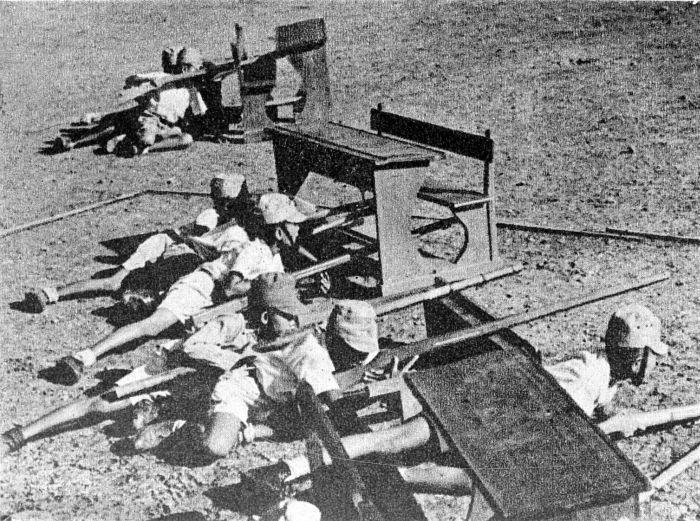
Indonesian History: Struggle for Indepedence -- Nationalists Seize Control (1945)

Figure 1.-- Here are Indonesinm boys being trained by the Japanese. We believe the photograph was taken on Java during 1945. Notice that they have been uniformed by the Japanese and are usung school desks. Older biys also being trained would for the core of the Nationlist Army in the war for independence againt the Japanese.
|
|
The Indonesians which had collaborated with the Japanese could see clearly see that the Japanese had lost the War. This was obvious by 1944. They began preparing for the inevitable Japanese surrender and Indonesian independence. The planning in 1944 was in secret so as not to incur Japanese repression. The Japanese fially committed to Indonesian independence, but continued to refuse to give the Nationlists any real authoriyy. But becuse the Nationalisrs did not confront the occupation, the Japanese decided to arm and train an Indonesian militia to help repel the expected Allied invasion which of course never came. This militia would become the core of the Indonesian Army that resisted the Dutch after the War. By mid-1945, the Nationalists became increasingly bold, understanding tht the Japanese would see it pointless to attack them thinking that the Allies were preparing an invasion. The first meeting of the Investigatory Commission for Indonesian Independence occured (May 28, 1945). Sukarno gave his impassioned Pancasila speech (June 1). The draft of the Constitution for the new Indonesian Republic was issued (July 16). The Republic set up its central institutions. The Republican government organnized in Jakarta (August). They formally adopted the draft Constitution. The Central Indonesian National Committee (KNIP) was established. Enthuiasm for independence spread across Indonesia. Local Japanese commanders and their troops for the most part even before the Emperor surrendered avoided confrontation with the Nationalists. They even turned over arms to the Nationlists, often under duress. Republican youths with little central direction took over government buildings and importnt infrastructure facilities in the larger cities. Much of this took place on Java which unlike Borneo was still in Japananses hands. For several weeks, mass pro-independence rallies for several were held. Empero Hirohito announced Japan's surrender to the llkies (August 15). Sukarno and Hatta issued a second declaration of independence (August 17). .
Sources
CIH

Navigate the Children in History Page:
[Introduction]
[Biographies]
[Chronology]
[Climatology]
[Clothing]
[Disease and Health]
[Economics]
[Geography]
[History]
[Human Nature]
[Law]
[Nationalism]
[Presidents]
[Religion]
[Royalty]
[Science]
[Social Class]
[Bibliographies]
[Contributions]
[FAQs]
[Glossaries]
[Images]
[Links]
[Registration]
[Tools]
[Children in History Home]
Navigate the Boys' Historical Clothing national pages:
[Return to the Main Indonesian independence struggle page]
[Return to the Main Indonesian history page]
[Return to the Main Indonesian page]
[Return to the Main Oceania history page]
[Australia]
[Hawaiian Islands]
[Kiribati]
[Marianas]
[Micronesia]
[Nauru]
[Palau]
[Philippines]
[Pictcarin]
[Samoa]
[Solomans]
[The Netherlands]
Created: 3:07 PM 10/14/2015
Last updated: 3:07 PM 10/14/2015



